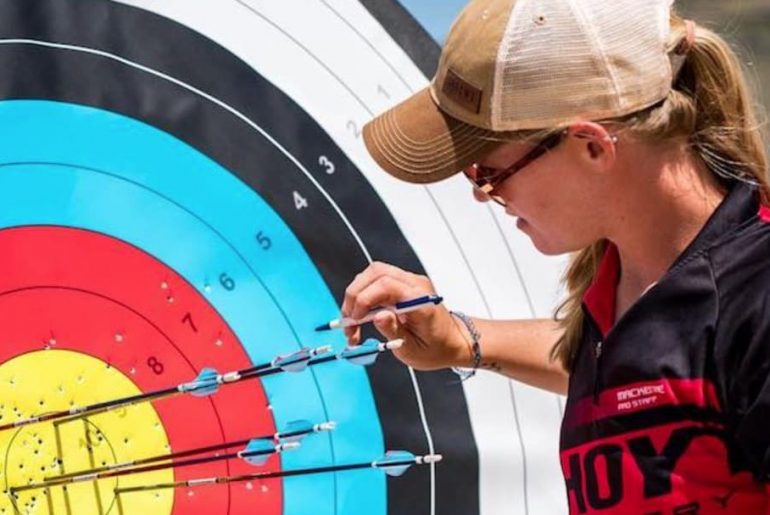From an original form of hunting at least 14,000 years ago and a long-distance weapon, the bow and arrow has also developed into a piece of sports equipment. Target shooting with a bow and arrow is already described in the legends surrounding Robin Hood. The oldest European school of archery dates back to England in 1545. In the early 19th century in Brabant (Belgium) archery had the status of a popular national sport. Archery also became a very popular sport in Great Britain, mainly for women. In Germany, however, it was not established as a sport at that time, despite the German gymnastics movement by gymnastics father Jahn.
Archery is one of the precision sports and uses standardized targets as a shooting sport with bow and arrow. It has been an Olympic sport since 1972 and was part of the Olympic Games program in 1900, 1904, 1908 and 1920. In 1904 it was the only sport in which women were allowed to participate. World Archery Championships have been held since 1931. In addition to sports, archery is also used in the meditative and therapeutic fields.
Archery technique
The mechanical principle of archery uses an elastic stick or bow that is stretched with a bowstring. By tightening the string, the bow acts like a spring. The potential energy built up is released as the kinetic energy of the arrow when the string is released. Therefore, the stronger the tension of the bow and the further the string is drawn, the faster, further, straighter and more penetrating the arrow will act.
The tension of the bow is traditionally defined as the draw weight on the string in pounds (1 pound = 0.453 kilograms) at a draw of 28 inches (71.12 centimeters). Bow draw weights vary from a few pounds for children’s bows to over 60 pounds (27.22 kilograms) for experienced archers.
Depending on the bow class and association, there are restrictions on the firing speed. Field and Forest are 300 feet per second, World Archery and Target have a draw weight of 60 pounds.
A special feature of archery, however, is to achieve a consistent shooting sequence through calmness and concentration.
Gear
Safety comes first. In addition to the right equipment, certain behaviors reduce the risk of injury.
Recurve bows with sights and stabilizers are the most common sports equipment in archery. This technologically advanced piece of sports equipment is often referred to as the Olympic bow. This allows accurate hits to be achieved over long distances.
Compound bows with a pulley-like mechanism have far greater draw energy. The pull force used by the shooter is approximately evenly high from the beginning until just before the full draw, which gives the arrow a higher impulse. The draw length depends on the shooter’s arm length and shooting technique. This includes the choice of the anchor point of the drawing hand for the maximum drawout of the string.
Quiver
In addition to the bow with or without an arrow rest and the arrows, the equipment includes a quiver, carried on the back or on the side. Some models can also be attached to the bow.
Clothing and protection
Are important for the archer
- tight-fitting clothing, as the tendon shoots tightly along the body
- Leather arm protection, which prevents bruising on the forearm
- a finger protection in the form of a “tab”
- or an archery glove
- or releases for the hand that pulls the string
- if necessary, a chest protector
- In “Olympic” archery, an arrow rest is used for shooting and a bow stand is often used to store the bow.
Bow equipment
The extension of the bow equipment by technical additions to the bow and the string is possible – depending on the type of shooting. These include various designs of arrow rests, bow sights, clickers, overdraws, peepsights, stabilizers for limbs and bows as well as accessories for the bowstring, such as silencers, kisser buttons and nock point aids (made of metal or “D-Loops”).
https://youtu.be/5U53PllOWvU
Shooting at targets
Target faces with a ring rating serve as targets, the ring number ranges from 10 to 1. These targets are divided into colors from the inside to the outside. Each color is in turn divided into 2 rings and stands for a certain number of points. Yellow (also called gold) = 10 / 9 points or rings; Red = 8/7 points; Blue = 6/5 points; Black = 4/3 points and White = 2/1 points. If you hit neither the target nor the target, this is rated as an M (miss).
The area of ten for compound shooters in the hall is 18 meters smaller than that for recurve shooters and is also marked separately. Such an X marking is also available outdoors. Here, however, the score counts as an inside ten. A hit counts when the arrow shaft touches the black stripe surrounding the ring. Rings 1 and 2 are dropped and in the event of a tie, the shooter with the most inner tens wins.
Shooting sequence
A traffic light or traffic light control regulates the shooting process, with a distinction being made between single and double row shooting. The length of the shooting time depends on the competition and is defined in the regulations.
After shooting, the hits are recorded by the shooters. The results are recorded by two people separately on so-called shooting slips. This includes the value of each individual arrow and the sum of all rings reached.
The most famous competitions
- WA outdoors (championships and Olympic Games): 2 times 36 arrows at a distance of 70 meters, then continue in the knockout process
- FITA Round or Great FITA: Shooting 144 arrows at different distances and targets (depending on competition class, age and gender). At the 30 meter distance, the target can also be replaced by so-called spots. For schoolchildren and youth classes, there are sometimes different regulations regarding distances and print runs.
- A FITA round is usually shot in one day, but the double FITA is shot in two FITA rounds on two consecutive days
Small or half FITA: 50 and 30 meters distance on an 80 cm target, 36 arrows each
900 round: 30 arrows each at 60, 50 and 40 meters on a 122 cm target - FITA Halle: Here there are two 2 rounds of 30 arrows at a distance of 18 meters on 60 centimeter faces (traditional bows and student class A recurve), 40 centimeter faces (bare bow and youth class recurve) or on 3 spot faces (Olympic recurve and compound bow)
- Bogenliga Halle: In a DSB league, eight teams with three shooters per match usually compete against each other. Each team shoots one match against the remaining seven teams on a competition day. A match consists of three to five ends (shots) of six darts each, two per contestant within a two minute time limit. A league season consists of 4 days of competition, in the final the four best teams from the 1st Bundesliga North and the four best teams from the 1st Bundesliga South compete against each other.
- Outdoor archery league: Here, too, there are teams with three archers each and everyone shoots 3 arrows at 50 meters on 80 centimeter targets. All shooters must shoot their arrows within 3 minutes. Each shooter shoots 3 times 3 arrows per competition, i.e. 27 arrows per team. Each team shoots against every other team and the winner gets 2 points each, ties get 1 point each. If the sum of all points equals a tie, the ring numbers also count.
At the DBSV, a team consists of four shooters and they shoot at 70 centimeter targets.
Archery disciplines
The term field archery or field shooting combines different disciplines of archery and is based on traditional archery. However, target devices or other additional equipment are also common here.
Field archery
In the narrower sense, field archery set up the targets in the terrain along a circular course. In contrast to the FITA target, these are black with a yellow inner circle. On a field course, the distances for at least half of the targets are not known and you can shoot uphill and downhill up to a firing angle of 45 degrees.
3D shooting
3D shooting uses foam animal figures as targets, usually on an archery course. In addition, the shots are not only made in flat fields, but also up and down. 3D shooting is similar to hunting without hurting animals. The aim is to place the arrow in the kill of the stylized animal, i.e. where the heart and lungs would be. A course consists of around 28 targets at which a maximum of 3 arrows can be shot. In small parcours and the so-called hunter rating, only one arrow may be fired from a peg. The shooter must be behind and touching this stake when shooting.
4D archery
4D archery uses large screens and a projector to enable training with moving targets. A special sensor registers the flight of the arrow and its impact on the canvas. Special polymer foams are used for these and the arrows can be reused as desired. There is hunting 4D and 4D where the target is clearly marked. With Jagdlichen-4D, on the other hand, nature scenes or animated content are used and the shooter has to guess where the so-called kill is.
Clout shooting, roving and flight shooting
- Clout Shooting: Aimed at a flag planted in the ground 165 meters away.
- Roving: The checkered flags are at different unknown distances
- Flight shooting or long-distance shooting: The aim is to shoot as far as possible.
Traditional archery
Traditional archery (instinctive or intuitive) uses bows without technical accessories such as sights or stabilizers on forest courses. In addition to the recurve bow in its form as a bare bow, there is the long bow, the rider bow and the primitive bow. Homemade bows are also used.
Mounted Archery
Mounted archery uses short horseback bows from horseback, mostly at a gallop, modeled on Mongolian warriors. This shooting technique is similar to traditional instinctive archery.
Kyūdō
Kyūdō is traditional Japanese archery, based on the ancient warfare technique of the samurai. Under the influence of Zen Buddhism, an art form of its own emerged. Both the design of the bow and the technique of shooting are completely different from sport archery.
Yabu seeds
Yabusame is an older traditional Japanese style of archery practiced from horseback.
Therapeutic Archery
Archery is offered as part of the treatment in many psychosomatic clinics, in therapy for children and adolescents and in rehabilitation.
Paralympic sport
Blind and partially sighted archers are currently fighting for recognition of this blind and partially sighted sport as a Paralympic sport.
Archery Organizations
The officially recognized international association for archery is the World Archery Federation (WA), represented in Germany by the Deutscher Schützenbund (DSB). Qualification for European Championships, World Championships and Olympic Games is only possible via the DSB. However, 3D field archery and 3D championships are not planned in the DSB. Therefore, the WA 3D World Championship took place in recent years without German participation.
In addition to DSB, other associations in Germany include the German Archery Association (DBSV) and the German Field Archery Association (DFBV). This is internationally connected to the International Field Archery Association (IFAA). This organizes qualification-free world and European championships of the incorporated national associations every year. Since field archery is becoming more and more popular as a mass sport, there has recently been cooperation between the DFBV and the DSB.





